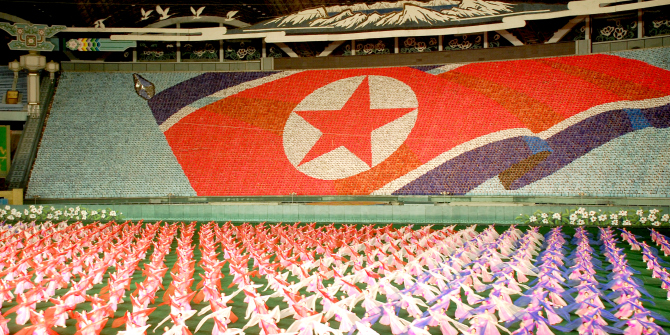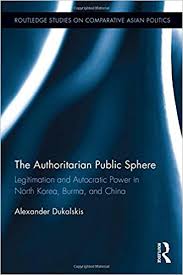Book Review | The Authoritarian Public Sphere: Legitimation and Autocratic Power in North Korea, Burma and China by Alexander Dukalskis
In The Authoritarian Public Sphere: Legitimation and Autocratic Power in North Korea, Burma and China, Alexander Dukalskis offers insight into the meticulous efforts of three of Asia’s longest standing authoritarian regimes to legitimise and maintain their rule. Utilising a comparative lens while also drawing on extensive interview data, this is a valuable contribution to understanding the myriad tools utilised to construct and control ‘authoritarian public spheres’, writes Sam Swash.

Pyongyang, Arirang (Mass Games), North Korea, 2007. Picture: (stephan), via (CC BY SA 2.0)
The Authoritarian Public Sphere: Legitimation and Autocratic Power in North Korea, Burma and China. Alexander Dukalskis. Routledge. 2017.
The tools used by authoritarian regimes to imbue acquiescence in their citizens are multi-faceted and diverse, going far beyond the vestigial repression often closely associated with autocratic states. So then, how are modern-day autocracies so resilient, able to enforce obedience and enduring social control in the face of international condemnation and transformative technologies? Alexander Dukalskis’s The Authoritarian Public Sphere: Legitimation and Autocratic Power in North Korea, Burma and China gives a captivating insight into the meticulous efforts made by three of Asia’s longest standing authoritarian regimes to legitimate their rule through controlling their citizens’ political discussions in order to quash subversive ideas that could destabilise them.
This analysis is undertaken via the conduit of what Dukalskis terms the ‘authoritarian public sphere’: an area which exists between the realms of public and private interactions. The idea of a public sphere was first conceptualised by German philosopher Jürgen Habermas, who defined it as a space where people come together ‘in a relatively unrestricted fashion to share their opinions and perspectives about political issues’ (26). Dukalskis focuses on this area within authoritarian states, where sites of private discussion are ‘frequently the target of state repression and manipulation’, resulting in the public sphere morphing into a domain in which the state ‘aims to manage and police political communication’ (27). Subversive ideas are capable of destabilising governments, and the overarching aim of the authoritarian public sphere is to stem the flow of these at their base – in the homes and workplaces of citizens.
One of the strengths of the book is the author’s ability to look at the subject matter through a comparative paradigm, something that has been missing from the literature for some time. And although Dukalskis’s comparative lens is focused on North Korea, Burma and China, the book is interlaced with gems of episodic reference to authoritarian regimes across the world, from Syria and Iran to Cuba and the military dictatorship of Park Chung-hee in South Korea.
Dukalskis has thereby created a unique analysis model which sets aside the need for the book to engage in convoluted, well-trodden debates around the meaning of ideology. Rather, the approach used allows the author to bring authoritarian ideologies with substantially different content – whether religious, communist or nationalistic – ‘into the same realm of analytic comprehensibility’ (143).
Instead of focusing on ideology, Dukalskis concentrates on six key functions of the ideological systems operated by the Burmese, Chinese and North Korean governments: their ability to ‘conceal, frame, blame, cultivate a sense of inevitability, mythologise and promise brighter futures’ (59). The principal aim of these activities is to subvert public discussion to such an extent that the public opinion of citizens is largely depoliticised, whilst sprawling networks of barely-concealed spies, informants and state security agents act as ever-present deterrents: the enforcing hand of the state that can deal quickly with acts of dissidence.
The research is further strengthened by a wide-ranging and rich body of interview data intertwined with the comparative analysis. Oral testimonies from Chinese, Burmese and North Korean citizens who have direct experience of living within their respective regime’s authoritarian public spheres provide compelling first-hand evidence that is applied to support Dukalskis’s theories. However, the author should probably make it clear that in the cases of Burma, China and North Korea, many of its citizens have never known a different state, regime or system: most will have lived their entire lives within the only system they know. This fact in itself could be just as powerful as the regime’s ability to enforce acquiescence through the public sphere.
Perhaps one of the most revealing parts of the author’s analysis is his acknowledgement of the fluid nature of ideology in each of the three countries studied. China and North Korea are both consistently labelled as ‘communist’, whilst the Burmese junta was typically viewed as ‘apolitical’ (98). But these catch-all ideological labels fail to reflect the shifting nature of the states in question. These long-standing regimes are often viewed as unchanging relics of a time gone by, a handful of states that continue to defy ‘the end of history’ as proselytised by Francis Fukuyama: the end of ideological battles between east and west and the triumphant victory of western liberal democracy. But these autocratic states are able to thwart these assertions through adapting their regimes to counter new challenges posed to their hegemonic power.
The analysis of North Korea is particularly interesting given that it is the most repressive regime of the three – it is easy to view it as an isolated pariah or a dangerous relic where the normal levers of political cause and effect are taken away. But this simple and pervasive labelling is often misplaced, refusing to understand the regime’s actions as logical consequences of its struggle for survival. Dukalskis’s analysis shines a revealing light upon the tools that allow the North Korean government to rule with such brutal effectiveness in the face of almost total international condemnation.
Dukalskis goes on to analyse three particular domains of potential subversion within these countries: the ‘capitalist’ shadow markets of North Korea; networks of independent journalists in Burma; and the growing internet presence in China. Despite the authoritarian power of these regimes, no regime is capable of completely stifling every criticism of its rule, and Dukalskis’s analysis attempts to understand how ordinary citizens navigate themselves within the strictures of the state to create spaces that have the potential to develop into critiques of authoritarian rule. However, even if many North Korean women earn most of their earnings in ‘illegal’ markets or a handful of Chinese nonconformists manage to post cryptic anti-regime messages on the internet, the state ensures its presence within these realms of private discussion is felt enough so as to reduce the opportunity for any form of significant opposition.
Whilst The Authoritarian Public Sphere is far more accessible than most academic works dealing with such topics, it retains a level of sophisticated analysis that credits its readers with an understanding of the subject area. In doing so, this book provides a judicious contribution to our understanding of how authoritarian regimes use the myriad tools at their disposal to actively manipulate the ways in which their citizens talk and think about politics.
Sam Swash is a postgraduate researcher at the University of Leeds whose research interests lie in the history and politics of North Korea. He has visited North Korea and his PhD project is a historical analysis of UK-North Korean relations.

 Find this book:
Find this book: 



 Democratic Audit's core funding is provided by the Joseph Rowntree Charitable Trust. Additional funding is provided by the London School of Economics.
Democratic Audit's core funding is provided by the Joseph Rowntree Charitable Trust. Additional funding is provided by the London School of Economics.